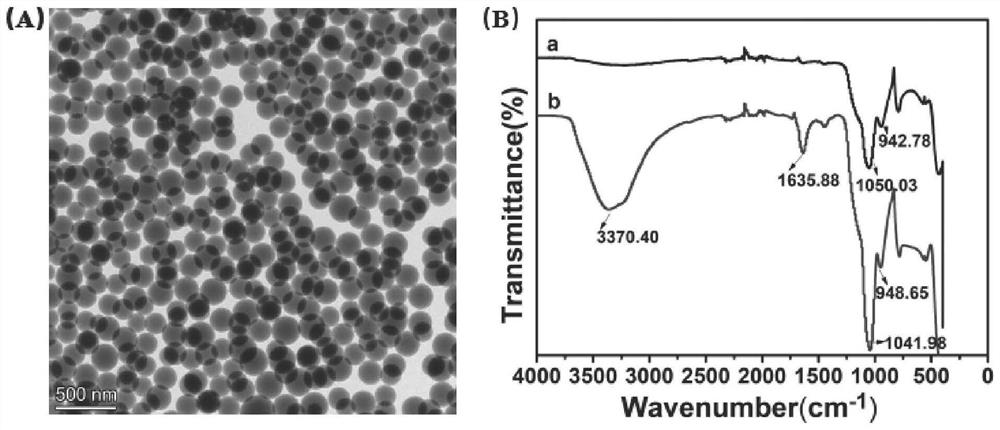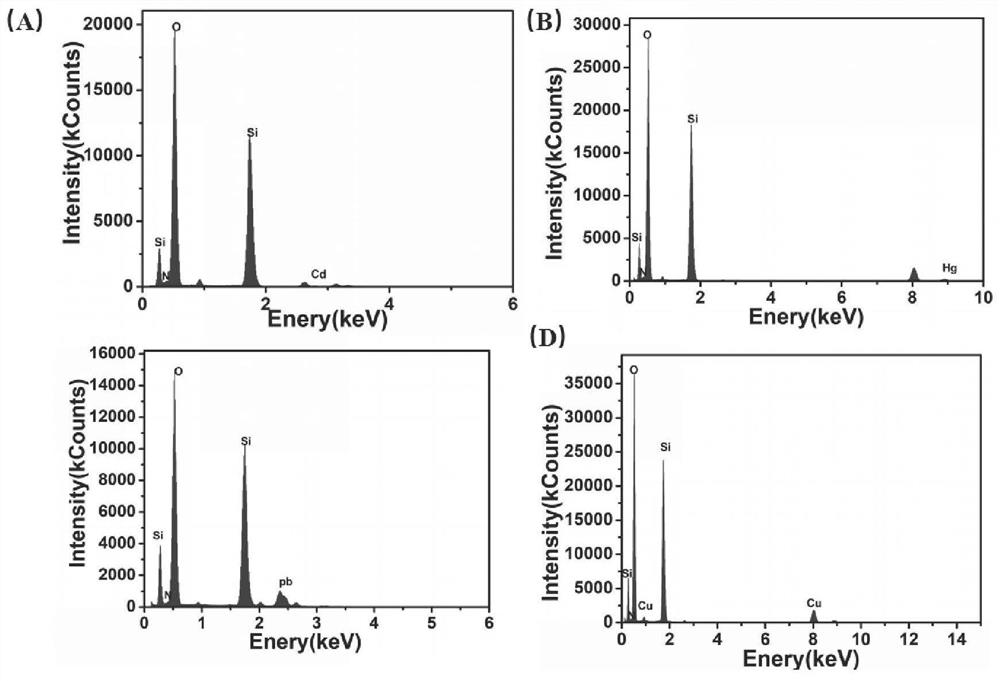In-situ electrochemical immunosensor for simultaneously detecting four markers of breast cancer
An in-situ electrochemical and immunosensor technology, which is applied in the fields of biotechnology and medical treatment, can solve the problems of inaccurate detection results, harm to the human body, and long detection time, and achieve the effects of improved sensitivity, low detection limit, and high accuracy
- Summary
- Abstract
- Description
- Claims
- Application Information
AI Technical Summary
Problems solved by technology
Method used
Image
Examples
Embodiment 1
[0038] Example 1 A method for preparing an in situ electrochemical immunosensor for simultaneous detection of four markers of breast cancer (1) Preparation of capture molecule silica-metal ion-antibody
[0039] 1) Take 28mL of distilled water, 65mL of ethanol and 7mL of ammonia water to form a mixed solution, then add 4mLTEOS and mix evenly, then magnetically stir at room temperature for 30min, and centrifuge and wash with absolute ethanol several times to obtain silica spheres.
[0040] 2) Add 0.022g of silica spheres to 2mL of ethanol solution, ultrasonicate for 30min to obtain a uniform silica sphere mixed solution, then add 0.4mL APTES dropwise to the above mixed solution, stir for 6h, mix and centrifuge to obtain The precipitate was washed 4 times with ethanol solution to obtain aminated silica spheres.
[0041] 3) Add 0.015 g of aminated silica spheres to 2 mL of Cd at a concentration of 10 mg / mL 2+ 、Cu 2+ , Pb 2+ and Hg 2+ and shaken at 30°C for 2 hours. After adsor...
Embodiment 2
[0050] Example 2. Method for molecular typing detection of breast cancer based on in situ electrochemical immunosensor for simultaneous detection of four markers of breast cancer
[0051] 1) Before use, use 1.0 μm and 0.05 μm alumina-water on a smooth polishing cloth to thoroughly polish the bare glassy carbon electrode (GCE) until a mirror surface is obtained, and then ultrasonicate the GCE in distilled water for 5 minutes to remove residual The alumina pellets were rinsed with distilled water and dried under nitrogen flow.
[0052]2) Incubate 10ul magnetic bead (MB) probes with proteins representing antigens of different breast cancer subtypes, shake gently at 37°C for 1 hour, magnetically separate and enrich the magnetic bead probes, and wash with PBS buffer to remove unfixed on the magnet Then disperse the immobilized magnetic bead probe in the mixed solution of 10ul silica-metal ion-antibody to carry out signal modification. After gently shaking and incubating for 0.5h, t...
Embodiment 3
[0057] Embodiment 3 condition optimization
[0058] The incubation times of magnetic bead probes and proteins representing antigens of different types of breast cancer were 20min, 30min, 40min, 50min, 60min, 70min, 80min, 90min and 100min, and other experimental steps were the same as in Example 2, and the experimental results were as follows: Figure 4 shown.
[0059] As can be seen from the figure, with the increase of the incubation time between the magnetic bead probe and the protein, HER2, ER, PR, Ki67 (Cd 2+ , Pb 2+ 、Cu 2+ , Hg 2+ ) The current signal also increased accordingly, and the current signal reached a plateau at 60min, 50min, 60min, 40min, and 70min respectively when the incubation time was 60min, 50min, 60min, 70min. In order to obtain sufficient detection current signals, the maximum incubation time of 70 min was selected as the optimal incubation time.
PUM
| Property | Measurement | Unit |
|---|---|---|
| concentration | aaaaa | aaaaa |
| Sensitivity | aaaaa | aaaaa |
| recovery rate | aaaaa | aaaaa |
Abstract
Description
Claims
Application Information
 Login to View More
Login to View More - Generate Ideas
- Intellectual Property
- Life Sciences
- Materials
- Tech Scout
- Unparalleled Data Quality
- Higher Quality Content
- 60% Fewer Hallucinations
Browse by: Latest US Patents, China's latest patents, Technical Efficacy Thesaurus, Application Domain, Technology Topic, Popular Technical Reports.
© 2025 PatSnap. All rights reserved.Legal|Privacy policy|Modern Slavery Act Transparency Statement|Sitemap|About US| Contact US: help@patsnap.com



